JAIPUR
The pink city of Jaipur is the India of a million tourist photos. The sunlit forts and palaces, the elephants and camels in rush-hour traffic, the dust, big moustaches and even bigger turbans, the hot pink sarees and rugged landscape of Rajasthan, everything is there, all the sights and sounds from a holiday brochure.
More important for Vaishnavas is the city’s role of offering protection to devotees of Krishna as they fled from historical aggression. Finding Krishna in Jaipur is therefore an extra and spiritually rewarding part of any visit.
Jaipur has had a long connection with Bengal and the devotees of Krishna. Back in 1570, King Man Singh was a follower of one of the Six Goswamis of Vrindavan, Raghunatha Bhatta. He sent thousands of builders and tons of red sandstone to create a temple for Rupa Goswami’s Govinda deity. It took five years to build and was the best of its kind in northern India. Later, in 1597 he sent his sons with a large Mughal force to help the ruler of Bengal, King Laksmi Narayana, chase away Isha Khan, who had attacked him. Man Singh later married the Bengali king’s daughter.
But only one hundred years after the temple was built, the fanatical ruler of India, Emperor Aurangzeb, sent his soldiers from Delhi to demolish the Govinda temple in Vrindavan. The deities were removed before the soldiers arrived and, after many years of being worshipped in several places, came to be installed in Jaipur.
The city was built by King Sawai Jai Singh II in 1727 and named after him. He ruled from 1699 to 1743. Previous to Jaipur, the kings had all been up in the hills in palatial forts like the one at nearby Amber. This new city was built on a flat plain and was designed for easy access and for trade, being perfectly situated between Bombay and Delhi. The king had the original city painted with a wash of pink – a popular colour in Rajasthan. Since those days the population has increased and the city has expanded.
The palace has a large garden where, in addition to the many monkeys and peacocks, the royal family used to keep crocodiles in the ponds. King Jai Singh II was a strict follower of Vedic building codes – his two-mile square city has nine gates and the streets are laid out in a grid system – so he knew about the codes for constructing temples. But the need of the hour was great and so Govinda was installed in a large garden pavilion with open sides. Now it is difficult to imagine Govinda anywhere else. The crowds that come to see Radha Govinda are large, boisterous and noisy, and full of devotion. There is much singing and dancing, circling of the altar, and the mood is one of joy.
Close-up of Govinda, the Lord of Jaipur
In the early part of Govindaji’s residence at the palace, the priests were from the Ramanandi sect. They removed Radharani from the side of Govinda and placed the deity in a back room, arguing that there was no scriptural evidence for that mode of worship. The young Baladeva Vidyabhusana countered that Rupa Goswami, the original installer of the Radha-Govinda murtis had been the most prominent follower of the great Chaitanya Mahaprabhu, and that for this reason the original worship was valid. But the Ramanandi priests insisted that if the sampradaya was authentic it must have a commentary on the Vedanta Sutra, otherwise it could not claim to be authorised. When Baladeva Vidyabhusana claimed that the Srimad Bhagavatam was the natural commentary on the Vedanta Sutra, the Ramanandis refused to accept this claim. This debate took place in the nearby ashram of Galta.
Baladeva Vidyabhusana
Baladeva turned to Visvanatha Chakravarti Thakura who was by then over ninety years old and many miles away in Vrindavan. He charged the young disciple with the task of writing a commentary on the Vedanta Sutra. Baladeva prayed to Govinda for the blessing to achieve this monumental task of scholarship. Completing it in a brief time he named it the Govinda Bhasya or ‘Govinda’s Commentary.’ Perhaps because of this intellectual and devotional triumph, the priests I spoke to when I visited in 2017 were all from the Gaudiya Sampradaya, originating in the Navadwipa area of what is now West Bengal.
When the then king of Jaipur, Maharaja Sawai Madho Singh ll, (ruled 1880-1922) travelled all the way from India by ship to attend the coronation ceremony of Edward Vll in London, in August 1902, he took with him not only vast silver flagons of Ganges water, but the deity of Govindaji Himself. Thus Lord Krishna arrived by ship to London at the very beginning of the 20th century.
The Amber Fort, home to the Kachawaha kings before the building of Jaipur in 1727
The village of Amber is at the foot of the hill on which stands the Amber fort, beloved of kings and tourists. There is a very old temple of Nrsimhadeva from the 14th century built by King Narasingh Dev some time between 1388 and 1428. When we went there, it took us a while to find it, and there was quite a bit of asking for directions, finger-pointing and broken Hindi, dead-end streets and climbing of stairs but we found Him eventually.
Sri Narasimha of Amber
As well as these old and beautiful deities we also visited the Radha-Krishna of Lokanatha Das Goswami, the spiritual master of Narottama das Thakur. They are named Radha-Vinode or locally ‘Vinodilal,’ and are also in a relatively secluded place off a busy shopping street. If you find the Tripoliya Gate then walk down the street opposite, you’ll find the doorway about 50 yards up.
Sri Sri Radha Vinoda, beloved deities of Lokanath Das Goswami
Radha-Gopinatha are the beautiful deities of Madhupandit and are very popular, being worshipped by many adoring devotees several times daily with joyfully played gongs and cymbals. If you go there you’ll be charmed, for sure. You’ll also get to see the original coat and hat of Madhu Pandit, made entirely of Tulasi beads.
Madhu Pandit’s Gopinath
Jaipur is quite well served by pure vegetarian restaurants where you can have food that is onion and garlic free. BMB and LMB are two we tried and were happy with. You just give any rickshaw driver these acronyms and they’ll know where you mean. In BMB you can order a ‘Vaishnava Thali’ – an all-you-can-eat special with refills of all the dishes including hot chapatis.
Queen Gayatri of Jaipur
The founder-acarya of the ISKCON, Srila Prabhupada, also liked Jaipur, and the locals gave him a warm welcome. Queen Gayatri Devi, a fellow Bengali, hosted him and his young western disciples in 1972, and also presented him with beautiful black and white marble deities of Krishna and Radha who now stand in Brooklyn, New York.
Radha Govinda in Brooklyn, New York, USA
Satsvarupa Das Goswami writes in his biography of Srila Prabhupada:
January 12, 1972
Some of Jaipur’s prominent citizens had devised a plan to share expenses and responsibilities in arranging a pandal program . … At Srila Prabhupada’s request, devotees from Delhi and other Indian centers came to Jaipur to join him.
Prabhupada took a small room within the Govindaji temple compound, and his disciples moved into a nearby house. …
Throughout the week-long festival large crowds continued to come for Prabhupada’s morning and evening lectures. Prabhupada would chant prayers from Brahma-samhita and then lecture in Hindi. Not only did the citizens of Jaipur honor Prabhupada, but they honored his disciples also. Here, more than in most other Indian cities, the devotees were treated not as foreigners or outsiders but as sadhus.
“This whole city is made of devotees of Radha-Govindaji,” Prabhupada commented.
The police chief, who visited often, was cordial and respectful. As Srila Prabhupada and his disciples went from place to place in Jaipur during the day, policemen would salute them, halting traffic to let them pass. People invited Srila Prabhupada to their homes, and they treated him like a king.
For accommodation we stayed at ‘The General’s Retreat’ which is large residential house now turned into an 11-room B&B. The grand-daughters of the famed General Umrao Singh run a clean and well-ordered establishment, with a large garden and generous breakfasts. It’s on one of the main roads into the city – Sardar Patel Road in the Chomu District – and close to a railway line, so you won’t be spared any of India’s transport sounds during day or night. But if you get up earlier in the morning and are active during the day, when the sun goes down you won’t find it difficult to fall asleep. Ask for one of the upstairs rooms so that the domestic noises won’t disturb you.
* * * * * * * * * * * * * * * * * * *
Travelling Around the South of India
This is my diary from a visit to southern India last December – January. My travelling companions and kind sponsors were Peter Hayes, Moira Keyes, and Gail Staveacre.
December 28-29: Bombay
After a sleepless flight to Bombay we are met at the airport and taken to the Chowpatty ISKCON temple, a splendid building finished in Rajasthan-style carved sandstone.
We settle in, have an excellent and proper Italian pizza lunch at the Govinda’s restaurant, and then take a long walk on the nearby Chowpatty Beach, famous for its annual Ganesh festival. The sun sets and we see some of the nightlife of Bombay.

Chowpatty Beach
Its India, so everything is family-oriented and polite. The most dangerous things the teenagers get up to is eating the red-hot curries from the beach vendors. We walk back to the temple, changing money along the way. The temple guestrooms are comfortable and we all quickly drift off to sleep.
First day in India, on Chowpatty Beach
December 30: Bombay
Bombay is a large, long, thin city spread along the coast. With the dense traffic it takes quite while to seriously get from one part of town to another. So we start early.
Marine Drive in Bombay
We leave the temple at 6.00 am for the Bhaktivedanta Hospital. It’s a large building on five floors. The nurses and other workers start their shifts with prayers before a statue of Srila Prabhupada. We tour the wards; see the young nurses training, the newly born babies, the operating theatre. On the top floor of the hospital is the special kitchen which prepares the midday meals for 45,000 schoolchildren. It’s a spotless place with stainless steel and marble in abundance.
Bhaktivedanta Hospital
From here we move on to Gopala’s Garden, the school for 150 devotee schoolchildren; the ISKCON Juhu temple with its new wing just about to open, and then the Gate of India.
The Gate of India, with boats leaving for the Elephanta caves
A 20-minute boat trip out to an island takes us to the Elephanta Caves, a rock temple from 500 AD. Its very hot, and the many steps up to the caves makes us sweat, but its well worth a look. Mango ice cream back at the temple.
Three-headed Lord Shiva flanked by his attendants: all carved from the cliff. No room for mistakes by the carvers!
December 31: Bombay then by train to Udipi
I led the kirtan following guru puja and the large number of young brahmacaries made it a very energetic experience with enthusiastic dancing. I then walked barefoot – “there will be no place to safeguard your shoes” – to attend class given by Niranjana Swami in a nearby Shiva temple. The sun was shining brightly in the sky and it was already warm as we walked carefully back to the guest rooms. We were served a great breakfast of cut papaya, apple, pear, a cool pina colada drink, and fresh parathas finished off with rasamalai, a traditional Bengali milk sweet.
Next to Lokamanya Tilak Station for the sleeper train down to Udipi, a Vaishnava pilgrimage town near the coast in the state of Karnataka. We have dinner of more parathas and vegetable subji that was packed for us and bless the devotees of Chowpatty for their wonderful hospitality. We are all too tired to see in the New Year at midnight, and 2006 becomes 2007 as we speed through the night on our way to south India.
Our travelling hotel for New year’s Eve
January 1: A New Year Begins
What a day. Udipi is reached at half past five in the morning and we take a taxi to the Swadeshi Hotel where we have rooms booked. I make a small altar on the table and we gather at 7.30 for a short kirtan. I explain some of the significance of Madhva and the south Indian acaryas generally and the temple culture of Udipi. We breakfast on traditional idlis – steamed rice dumplings – and wada – savoury dahl ‘donuts’ – then walk the short distance down the hill into the temple square, the very heart of Udipi.
Wada ‘donuts’ and idli ‘dumplings’
Joining the line of pilgrims, we pass through the metal detector at the main entrance. Here, all males remove their shirts, a traditional practise for visiting temples in the south. The inside of the temple is lit by occasional shafts of sunlight but the black granite interior still makes it cool and dark after the brilliance outside. We slowly reach the position where darshan of the deity is taken and we look through a metal grill with nine windows to where the form of Lord Krishna holding a butter-churning rod is standing. Sri Krishnaya namaha!

Lord Krishna, the reason for the entire town of Udupi
Krishna was brought here around 1250 AD by Madhvacarya, the great Vaishnava saint. He was on the beach at nearby Malpe chanting the names of God when he noticed that a ship was in danger of running aground on the rocks. Waving his top cloth he warned the sailors who, in gratitude, gave him the only thing that a renounced monk could accept, a large boulder of clay they were using as ballast. Madhvacarya intended to use the clay for tilak, the forehead markings made by Vaishnavas. There would be enough in this boulder to last the entire ashram for many months. When the clay was broken, the deity of Krishna was found inside. Taking this as a direct gift from his Lord, Madhva installed Him in a temple and the town grew up around Krishna, the Lord of Udipi.
Madhvacarya, the Vaishnava saint who brought Lord Krishna to Udupi.
There are eight temples surrounding the town square in Udipi with the Krishna temple very prominently situated. Each temple was established by a sanyasi and resembles all the others in size and architecture. (I manage to visit each one before we leave). For 800 years the heads of each of the eight temples have followed a system of taking it in turns to become the head of the main Krishna temple. Every two years there is a grand ceremony as the head of the Krishna temple surrenders his post to the incoming sanyasi. The retiring sanyasi then has 14 years to raise funds for the entire cost of running the temple during his next term.
We talk to one family who are holding an upanayanam diksha, a spiritual initiation, for their 12 year-old son today. I ask if we can attend and they are happy to have us. It turns out to be a traditional ceremony in one of the eight surrounding temples: this one is dedicated to Lord Narasimha. It’s a very involved ceremony during which the ‘new birth’ of the child is signified by recreating the womb, covering him in white cloth and winding kusha grass around him. He receives the gayatri mantra – a traditional mantra with 24 syllables – from his guru, who also shows him how to count the mantras on his fingers and how to execute some preliminary daily spiritual duties. We left the family after offering our blessings to the boy and leaving a donation, returning later for a traditional ‘Udipi Brahmin’ lunch of 25 different dishes.
A traditional south Indian dinner. In addition to the wada and idli there are dosa, crispy pancakes rolled up and served with coconut chutney. All served up on a banana leaf!
After some shopping we attend the colourful Rathayatra in the evening. There are huge puppets, fireworks, saxophone musicians, flags, an elephant, cannons firing, and of course Lord Krishna as the centre of attention.
January 2
I could only fall asleep after midnight last night, but still managed to rise at 4.00 to join the others at 4.30 in the hotel lobby to walk down to the temple for mangal arati. To my surprise there was no drumming or nagesvaram music as there was at this time in the morning the last time I’d visited. My last visit coincided with the ‘100,000 Lights festival’ during which the town was thronged with different singing groups and lit up by countless candles at night. But we had our early morning darshan of Krishna, the deity said to have once been worshipped by Lord Krishna’s queen, Rukmini.
The front of Udupi Krishna temple
Returning to the hotel, I fell asleep and did not wake until 10.00. By this time, Gail had already booked us all as contributors to the Rathayatra that night, as well as sponsors of the pujas throughout the day. Gail was delighted at the puja she’d already attended and told me that we’d all been invited to lunch in the prasadam hall. Peter felt unwell and Moira was keeping him company so I ate with Gail. Lots of rice and rasam or vegetable soup, augmented by a delicious chutney made from dates, tamarind and corella (bitter melon) Following that we were served payasam or sweet rice, with date parathas.
We change our pounds into rupees, and feeling incredibly rich visit some of the surrounding shops. I buy some small old bronze items, an old ghee lamp, and some new brass puja items for when I conduct weddings. I also visit a music shop and buy some south Indian music tapes for my daughter Jahnavi. She plays violin and finds Indian music – particularly the southern or Carnatic style – fascinating. Gail and I then visit some of the other small temples which surround the square. They are mainly empty but it is good to see how the town centre is organised. Udupi is centred around it’s temples because the town grew up because the temples were here. In one respect, not a lot has changed in 700 years because the same things are important to the local people. Modernity and the attraction of technology is also here though, as it is throughout India.
Lord Krishna’s chariot
The evening is a trip to Vaikuntha, it really is. We watch the swami perform puja from a privileged vantage point just to the side of the main altar, then accompany him to watch Krishna being taken out on a boat around the temple ‘water tank’ – a good sized pond with surrounding walls. Three different groups of musicians play music to Him as the illuminated boat passes three corners of the square tank.
Lord Krishna’s evening begins with a boat ride around this temple ‘tank’
After the boat ride, He is placed on a gold-plated, purple-cushioned, palanquin and borne through the temple passages and out into the courtyard at the front of the temple. Krishna is then lifted high onto the majestic silver chariot and positioned safely with a comfortable view of all His devotees. I smash a coconut, the elephant trumpets, the band plays, I grab the ropes and pull the chariot (along with a hundred others!), and we are off.
Halfway round comes the fireworks and crackers. Big roman candles are set off sending up fountains of sparkling white light into the night sky. Then comes minutes of Chinese firecrackers on the road. Crumbs of highly flammable camphor are positioned in a long line stretching down the road before the chariot and set alight. They burn with small yellow flames. For some reason still unknown to me, there are two children in strange red, white and black devilish costumes dancing through the flames. Then two eight feet long pieces of white cloth, soaked in ghee, are raised on poles and set alight. Two pillars of flame light up the road, a flaming doorway for the Lord to pass through.
Slowly the chariot lumbers back to the temple, me straining at the rope and sweating in the humidity. There are concluding pujas within the temple hall, a gift of some rupees to the swamis who reciprocate by giving us cloth worn by Krishna, sweets and dry rice. We also give small rupees to the Brahmins and cooks and have a light meal of idli ‘loaves’ with sambar, a light wet vegetable dish, coconut chutney and banana halvah. What a night!
A swami in the Udipi temple
Our train south from Udipi, which we are to catch at midnight, does not arrive. The Midnight Express becomes the 1.30 am Express. Not surprisingly, although it is officially named the ‘Super-fast Express’ the speed is no more than what we would term medium, and what the French would call very slow. Its all in the perspective. I spend a disturbed night on a narrow upper bunk but 18 hours later we are in Cochin.
January 3: Cochin-A Christian, Jewish, Chinese, Hindu kind of town.
After a very careful midday breakfast of chips and spring rolls in the vegan restaurant of the Bharat Hotel where we’re staying, we take auto rickshaws to Old Cochin, beginning our visits to famous landmarks with the first ever Christian church in south India. Then to the Chinese fishing nets that line the river. We continue to the old Jewish synagogue. It is hundreds of years old and very attractive inside with polished brass fittings and dozens of glass chandeliers. The only sad fact is that the local Jewish community, the first and oldest in India, has dropped to around 50 souls. And most of them want to ultimately leave to live in Israel.
The old Cochin synagogue. (Only there isn’t a new one, nor is there likely to be)
Next to a well constructed old wooden palace that has beautiful paintings of the Ramayana on the king’s bedroom walls. The area of Cochin we’re in is steeped in Catholic history and there are many small churches. There are also many surprisingly well-stocked antique shops – honey-traps for us tourists – and although we are strapped for time I bargain for a ghee lamp and a bronze spoon.
18th century mural of Sita and Rama at the Matanchery Palace
At 6.30 in the evening we attend a traditional kathakali performance preceded by a demonstration of make-up and an explanation of the emotions and the mudras – hand gestures – expressed by the dancers. The elderly dance-guru of this institution danced for 50 years, beginning in 1958. His two students are very good and wear striking costumes. I am convinced of a Chinese connection for this relatively modern art form.
Kathakali performer getting ready
January 4: Allapey – Where I get lost
It’s a nice view from my window, looking down on the harbour. I chant, walking back and forth in my room as the sun rises, and pack after breakfast. Krishna, our driver for the next two weeks, has arrived with a 13-seater vehicle. Bigger than we need but very safe looking, and Gail has used the company before so they’ve been generous.
I chant a Ganesh stuti for blessings at the beginning of a journey, crack a coconut, and we all throw rice – we are off to Allapey, a town whose name is spelled in at least four different ways. I am to remember Allapey for the rest of my time in India.
The journey passes smoothly and I see more of an Indian state I’ve never visited before. Allapey has a canal running through the town with numerous houseboats bobbing on the water. They are large craft with decorative wooden prows and sterns, surmounted by a thatched enclosure with several rooms and even balconies.
Houseboat in Allapey. Originally rice boats, there are now many of these plying tourists along the peaceful backwaters
We have breakfast in town after briefly visiting our guesthouse where the proprietor is out. Foolishly I fail to take note of the name of the place or the location. I will regret it later. The ‘hotel’ where we eat, although ‘Veg’ as opposed to ‘Non-Veg,’ is pretty dingy and grubby, and the food is about the same. We all agree – I think – to meet at 6.00pm by a festival arch in the centre of town. I go shopping and am successful with some brass and bronze in a small place two miles out of town ‘where tourists don’t go.’ I actually believe the guide who takes me there as the prices are OK. I buy some dhotis with ice-cream shade borders (the middle-aged Vaishnava equivalent of Hawaiian shirts) and order some kurta shirts to be stitched and one for my son Mali. I even buy reading glasses. Its been a good day, but then it all starts to go wrong.
I wait for over an hour at our designated spot, and then become concerned that one of us got the spot wrong. It couldn’t be me of course – the seasoned India traveller and pilgrimage organiser.
By this time I am hungry and eat up the road at the ‘Hot Kitchen’ – some alu-gobi (potato and cauliflower) with chapattis, and vegetable rice and veg cutlets. Well I said I was hungry. It’s a fine meal but I’m getting worried as its getting dark.
I call England and ask my daughter Jahnavi to text Gail with my location. Some time after I jump on an auto rickshaw to try to find our guesthouse myself. All I can remember is a red earthen lane leading to the place and an unpronounceable Malayalam name beginning with a ‘T.’ I try waggling my tongue in a dozen different ways to recreate the syllables of the name of the place but the driver looks even more bewildered. As bewildered as I now feel.
An autorickshaw in Allapey. My mind was as empty as this one.
All this time Gail and Peter have been waiting for two hours by the bridge, then driving up and down in that area trying to find me. I call home again – cheap these days from India – but the message has not been sent. My mind is somewhat desperate but my intelligence is alert to the suspicion that this is such a bad communication period it must the shadow of some inauspicious stars. (Blame it on the stars then)
I phone again to get Gail’s mobile number but cannot get through. It turned out that I had been misinformed when told that you have to dial 00-44 if the sim card was bought in the UK. By this time I begin thinking about staying somewhere else for the night. At 10.30 pm I am just negotiating a price with a dodgy-looking chap on a motorbike when Peter and Gail turn up with our large, safe-looking van. The guesthouse manager, Mr.T.A. (Jacob) Chacko is also with them. They have already visited the hospital and the police station and have only just received a text from my daughter Tulasi. We are all relieved, and back at the guesthouse, Moira is particularly relieved. All’s well that ends well. Suitably humbled, I fall asleep on a Mickey Mouse pillow.
January 5: A day and a night on the peaceful backwaters.
After a breakfast of fruit, toast and yoghurt on the balcony we walk a few yards up the road to an Ayurvedic centre. The thing to do while you’re in in Kerala, apparently, is to have a full body oil massage and an excursion on a houseboat. Today we got to do both.
I was laid out on a huge, thick teak table in a room with a corrugated tin roof. Peter, Moira and Gail were all in other rooms. I took comfort that any pain I would experience from the heavy massage was going to be shared by all of us. I shouldn’t have worried. I was massaged from head to toe for one hour. The man knew his stuff, and although I winced a few times the Carnatic violin music was enough to comfort me.
We collected our overnight bags from the guesthouse and followed Mr. Chacko down tracks and through back yards, past men working on boats, to the edge of the water where ten houseboats were moored. These boats are very big up close and look like a thatched cottage placed on top of a Viking longship. Ours was owned by Mr. Chacko and had a crew of four. There were two twin rooms, a sitting area with a table upon which had been placed a platter of fresh fruit, and an upstairs balcony.
After a few minutes we set off, engine running quietly, onto a large placid lake with purple water lilies and a variety of birds. From the balcony Peter and Moira were spotting many colourful birds, some as large as kites or as small as hummingbirds.
We moored up after maybe five miles and arranged for lunch. While I was saying the prayers a crow stole the puri from the offering plate. Undeterred by the attention of some of the thousands of birds flocking in this watery countryside, we had a nice lunch, gently rocking as another boat passed by, or pausing briefly as someone paddled up trying to sell us huge prawns or some other unfortunate river creature.
Moira relaxes on the top deck
We continued along the waterways, studying the village life on either bank, watching the birds through binoculars, or getting down to some quiet reading. What a change this was from the normal clamour of India’s roads. We stopped for the night and the crew tied up the boat to coconut trees. Peter and I jumped in the water. It was warm yet cooling – perfect for the end of a hot day. A small Durga temple nearby provided us with a spot to visit. But we hardly needed any more to see after watching life on the riverbank all afternoon.
Jumping off the boat into the water at the end of the day was wonderful
And so was breakfast the following morning
January 6: Temples, Palaces, and an Ashram on our way to the Beach
I awake at 2.30 am with a mosquito buzzing in my ear and cannot fall back to sleep. I chant sixteen rounds walking up and down the river bank, under the palm trees and the golden moon. Then, just as the east is beginning to glow, I chant my Gayatri mantra with my feet in the water. The canal is still warm. Sitting up on the balcony I hear a brahmana chanting his morning prayers very loudly. His confident voice echoes across the water and fills the space with sacred sound. I go to see him and give he and his wife a donation. Their house is no bigger than a room. Later, he comes back with a picture of his acarya and sings his guru stuti just by the boat. He smiles a lot.
We return to Allapey by 9.30, pick up our bags and driver, laundry and tailoring, then head off to Varkala, a beach resort where we are to spend three days. We make four stops along the journey, all to interesting places.
First is a Parthasarati temple – a place where Krishna is worshipped as the chariot driver of Arjuna. Days later I learn that this might be the place where Bilvamangala Thakura lived and wrote the Krishna Karnamrita, later treasured by Lord Chaitanya.
Then we stopped off at a ‘Snake temple’ with ‘30,000’ snake sculptures, all decorated with yellow turmeric powder. Then, some miles later, an old summer palace of the King of Travancore, Marthanda Varma. This naturally air-conditioned palace, with cool breezes blowing through it, had some great rooms.
The entrance to Krishnapuram Palace, the summer home of the King of Travancor
My favourite aspects were the sunken courtyards, the indoor swimming pool, the heavy carved wooden architecture, and the giant mural of Gajendra Mokshana, the liberation of the elephant Gajendra. Its a favourite story of mine as it closely relates to the struggles of devoted yet clumsy souls who somehow are saved by the Lord. I was once told to meditate on this story by an astrologer in Vrindavan. The king would meditate on this large, colourful painting after he had taken his bath in the pool. Although surrounded by luxury, the king was always apprehensive of the plans of the neighbouring kings.
This is not the mural in the palace, but a painting of the same story
Next was the ashram of Amritanandamayi Ma, the ‘hugging guru.’ Near the tsunami-ravaged beach villages the place is an international centre for her followers from around the world. Some ten-storey buildings. Lots of Europeans were there, all with their own philosophies it seems, but united by either curiosity or devotion to ‘Amma.’ There was a large auditorium for her regular audiences, during which she hugs thousands of people in turn until the early hours of the morning. Some rather serious white-clad disciples were in evidence, but mainly foreigners in yoga clothes. After more mercifully air-conditioned driving we arrive in Varkala.
Aerial view of ‘Amma’s’ ashram on the tsunami-hit coast
January 7: Varkala – We begin three days of beach life
Varkala is a beach resort for Europeans. Its like Kovalam to the south but a bit more sattvic with many Ayurvedic clinics, a government nature-cure hospital, and endless Tibetans and Kashmiris selling pretty much the same things: shawls, hippy chic, modern brass items and Free Tibet paraphernalia. The spiritual seekers and the vibe tourists are all here in their hundreds, baggy trousered, flowing topped, suntanned and the ‘I’m in India’ look.
Varkala; down on the beach
All the shops and hotels are spread out along a mile of clifftop, and thats where all the people are. This being India there are no safety barriers or warning signs. It looks as if some of the cliff has already fallen into the sea 200 feet below.
Varkala; the view from the cliff top
Breakfast is in a nearby ‘Juice Shack’ and other meals in a vegetarian restaurant around the corner. I’m a bit suspicious of the restaurant because it doesn’t look too clean, but it turns out they produce great meals during the whole stay and we don’t get sick. Our rooms are in a newly built block so they are quite well done and free from grubbiness. I chant, read, explore the cliff top and read and talk more.
January 8: We are barred from a temple and a palace but find a museum.
To Trivandrum – or Tiruvanantapuram as it is now – with Peter, driven by Krishna, our man at the wheel. Its over one hour to get there and we arrive just before 11.00. It is hot, but we remove our shirts in preparation for darshan at the Padmanabhaswami temple, a ‘brother temple’ to the Adi Keshava and Janardana temples in Tiruvattur and Varkala respectively. The brahmana at the East Gate tells us to go round to the North gate. Uh-oh, I don’t like the sound of that. We are in bare feet and the tarmac is like a frying pan on our tender British toes. The brahmana at the North gate directs us to the Guard Room, which sounds ominous, and the head guard directs us to the King’s palace, where we can get permission in writing to enter the temple. Well, we patiently go to the palace – a trek across town – but the guard there tells us that: “They always send Westerners here, but they never get permission.”
Gate tower of the Padmanabha Swami temple showing the rather nice Guard Room
Next is the Napier Museum, where we do get to see lots of deities, sadly now no longer worshipped. They are bronzes, naturally, dating back to 1100AD and through to the 1700s. Absolutely amazing craftsmanship. There are intricately carved ivories and fantastic wood carvings. The other museum in the same gardens holds original paintings by Ravi Varma but we don’t visit.
The Napier Museum, where someone finally lets us in..
A visit to another older palace reveals a great collection of the king’s posessions including white marble Krishnas from the 1700s and weapons, dancing rooms, a small meditation chamber, and incredibly decorated ceilings. A gorgeous painting of Vishnu on Sesha takes my eye. But they have not organised a ‘museum shop’ to squeeze extra revenue from the tourists. Lunch is at a nearby air-conditioned restaurant – it is really hot down here – and I have dosa and pillau rice, just to be on the safe side.
January 9: Sunrise meditations and an old temple.
Another restful day with good chanting on the cliff top at sunrise. I see Gail and Moira already sitting like meditating yogis down on the golden sand chanting their rounds. They look out to the horizon as the sun slowly rises over the waves.
The Janardhana Swami temple in Varkala. The architecture here is different from the north or the east of India.
After breakfast we walk along the beach to the Janardhana Swami temple. Its about 800 years old and as well as an altar to Vishnu, also holds shrines to Ayapan and Hanuman. There is an enormous banyan tree in the courtyard under which musicians stand and play their ‘violins.’ They will sing a song of offering on your behalf and place your name inside the song.
There’s another tree where hundreds of worshippers have tied pieces of ribbon to the branches and left dozens of plastic dolls. When you see this inside a shrine in India, it usually means that couples have prayed for fertility here then offered a ‘child’ if they’ve been successful.
An English woman with a young baby is inside the temple. It is the child’s first grains ceremony, the annaprashna, and as a few rice grains are placed within his tiny mouth the nageshvaram pipers and drummers begin to loudly play, surprising the child. I ask the mother where she is from and she explains that she’s from Nottingham and her husband is from Kerala. They return here for all important family occasions.
Some swimming on the way back, lunch, reading (I pick up a copy of the Narayaneeyam, a 1,000 verse summary of the Srimad Bhagavatam) a little shopping, then I telephone my mother and sister who are surprised to hear from me.
January 10: Beetroot juice, rubber trees, and a mosquito convention
The humble beetroot – do not underestimate its cleansing power
I rose early and managed some more good chanting. What a difference it makes to the entire day. Chanting japa before the sun rises should never be underestimated. I have beetroot juice with ginger for breakfast and we are all packed and travelling away from Varkala by 11.00.
We stop off at Kovalam just to see why its a top holiday destination. Its warm already but raining very lightly and the beach is already busier than Varkala, so we don’t feel we made the wrong choice of beach. I don’t get any further than a nearby antique shop where I find a nice heavy bronze panchapatra, the vessel used for holding water during puja. I have others of course, but a man can never have too many panchapatras.
The Western Ghats. India is not as flat as you might think..
Kerala gives way to the Western Ghat mountains which signal that we are entering Tamil Nadu. We cross the border and the script on the road signs and shop fronts changes. Gradually the local people become noticeably darker in colour. We stop off at a roadside restaurant that has an enormous ‘VEG’ sign. The owner has met our devotees before when they passed through on padayatra, a walking pilgrimage which travelled all around India in 1986 and for a few years after that.
Tamil script, one of my favourites
The restaurant is set in a rubber tree plantation of 300 trees. They are all dripping the white milk which gradually turns into rubber. The proprietor makes 500 rupees – around £6.00 – every day just from the rubber. A truck comes every day to make the collection.
The dreaded mozzy. Take all precautions to guard yourself against them!
We reach our hotel at Nagercoil. There seems to be a mosquito convention going on in this particular hotel, and I am bitten three times in as many minutes. The insects probably like foreign food! The town does not seem to have any distinguishing features but there is a large bus station and I gather that it has built up over the years mainly as a busy crossroads town. Our hotel is right on the main street above the traffic but after I take all adequate precautions so I won’t be eaten in the night I fall asleep quite easily.
January 11: An even better day!
What a trip to the spiritual world this morning was. I chanted twelve good rounds from 5.30 in my room and we all met up at the bus to go the few miles to the village of Tiruvattur and the Adi Keshava temple where Sri Chaitanya Mahaprabhu discovered the Brahma Samhita, the prayers of Brahma when he attained the grace of the Lord. It is around 8.30 when we arrive and, walking up eighteen steep steps, are greeted by one of only four brahmanas serving the Deity here.
Adi Keshava temple in the village of Tiruvattar.
He is to be our guide and takes us into a wide cloister passage with intricately carved pillars – 224 to be precise, all with different forms of Lakshmi. The inner area encloses the most amazingly carved wooden mandapa (canopy) I have ever seen. Hundreds of figures in dark teak, all crafted by expert hands 500 years ago.
224 pillars line the cloisters of the Adi Keshava temple
Our guide then shows us the spot where the Lord recited the Brahma Samhita. We sit in the mandapa, only a few feet away, and chant the verses of the Samhita. It is a very moving experience.
A popular artistic rendering of Lord Vishnu (Adi Keshava) reclining on the serpent Ananta Sesha. Brahma can be seen atop the lotus issuing from Vishnu’s navel
Then we finally get to have darshan. The Deity of the reclining Lord Vishnu is eighteen feet long and visible in sections through three windows. Although the chamber is very dark, and the form of the Deity is black, the pujari lights up His face and we gasp at His beauty. He is truly amazing to see, and awe-inspiring to pray to. After a short arati offered to Krishna, we give donations and continue our journey feeling very blessed to have come to this lesser visited place.
Padmanabha-puram Palace. The top picture shows the front of the palace with the sacred conch-shell symbol on the lawn. The lower shows some of the wood carving
We visit the Padmanabha-puram Palace next, an intriguing architectural creation that really showed us the life of kings of the past. So much carving – and so much space for the royal family to live.
This is the location of Kanya Kumari – the ‘Land’s End’ of India – an awfully long way from Delhi!
After this it is time to go to Kanya Kumari – the Land’s End of India. It is here that the Indian Ocean and the Arabian Sea meet. South of here there is just ocean – all the way to Antarctica. It is a tourist spot of course, where just about everybody who is selling anything sells shells and postcards. There is a very large statue of the famous Tamil poet and moralist Tiruvallur who wrote the handbook on life known as the Tirukurral. It is an enormous statue actually, built on a rock in the sea, looking back at India. He is 133 feet tall, weighs 7000 tons and is made of 3,681 solid granite blocks. His book, by the way, is a good read.
A shell-seller on the sea-shore. The gigantic Tiruvallur statue is in the distance.
Out on another rock is the spot where Vivekananda meditated before going to America. There’s a temple on yet another rock, a Gandhi Museum painted bright pink, and a ‘Viewing Tower’ where tourists can climb up to have a good look at the sun setting over the distant horizon. We find another high spot on top of a hotel and sit there for a few minutes while the sun sinks behind some clouds and darkness comes quickly. I was glad we didn’t pay for the Viewing Tower.
Catholic church in Kanya Kumari
After sunset, and just a little way from the shore, we visit a small Christian church. We feel we are in Mexico because the church sits in a town square which is entirely composed of golden sand, now cooling to the touch. This being India, we must remove our shoes before entering the church, and inside there are no pews, only a few chairs right at the back. Its a Catholic church of course, so the Virgin Mary is here, but garlanded and decorated with flowers as the deity would be in a Hindu temple.
January 12: Travelling to Madurai
This morning I overslept and was 20 minutes late for our departure at 7.00. We had a long journey ahead of us – some seven hours – so we had decided to start out early. As it happened the journey would only take five hours. Shortly after leaving Nagercoil with the mountains on our left hand side, we noticed that the wind sprung up quite suddenly. We are trying to avoid turning on the air-conditioning because we all have coughs and sore throats and the constant change of tempreature may have something to do with it. So we have the bus front windows open and it gets really blowy. It is strange to all of a sudden see trees outside blowing as if in a gale, peoples’ hair blowing, and bits of paper flying around. What was going on?
Here are two wind generators – we saw literally thousands along a 5-mile stretch of road
Half a mile later we saw that the wind must be a feature of life in this district because we saw a large white wind generator. Then another on the other side of the road. Then five more, ten, twenty. To our astonishment we were now driving through a forest of white wind generators, all revolving wildly like aeroplane propellers. This went on for miles – maybe more than five miles – and then suddenly it was all over – no wind, no propellers. There must have been a lot of them. It is a good thing to harness all this free energy.
We arrive at the Hotel Supreme in Madurai. The rooms are nice but the food is not: undercooked, overspiced – and overpriced!
A high view of the Meenakshi temple in Madurai – note the number of towers
We go with a temple guide organised by our driver and he shows us Madurai temple. It is a truly amazing place for sculptures. The gopurams, or gate towers, which mark the directions on the perimete of the temple grounds, are covered in them in a riot of rich colours. We spend so much of our time looking upwards! The east tower was built between 1216-1238 and is 153 feet high. It is covered in 1,011 sculptures and has nine stories.
Goddess Meenakshi – she whose eyes are shaped like fish – is given in marriage to Shiva
Inside the temple it is quite dark but noisy with the sound of pilgrims and piped chanting of Vedic mantras. We offer coins to a huge elephant and get blessed or ‘dobbed’ as Gail calls it. Our guide shows us one pillar which, when struck, plays all the musical notes. Another pillar and he asks us to place our ear to one arm of the sculptured granite figure while he taps the other one. You can hear a musical note ringing through the stone. And then we are in the hall of a thousand pillars. We asked the obvious question – it was 985. There is a large bronze form of Nataraja (Shiva) at the end of the hall, and many Chola bronzes on display. This was to be the closest we got to having darshan.
 The large water tank at the centre of the temple – this was the furthest we got
The large water tank at the centre of the temple – this was the furthest we got
Despite our polite reasoning with the official we were not allowed any further than the other tourists. When I asked what he wanted as proof we were actually Hindus he replied that the minimum was a signed document from the head of our organisation saying that we had ‘converted’ and also proof that we’d changed our names. Also, he wanted a document from our previous Christian minister saying that he or she had officially released us from baptism. I imagine that both Sivaya Subraniya Swami (a western convert to Hinduism who had devised those particular details of Hindu conversion) and the Shankaracarya had a lot to do with these notions. Nevertheless it was a good visit.
January 13: To Trichy
This morning is a long trip to Trichy from Madurai. Althought the countryside is green and it is coming to harvest time, the state of Tamil Nadu, through which we now drive, seems to have begun an ambitious road-widening scheme – but in sections all over the state.So one minute you could be on a wide, smooth tarmac road and the next on a bumpy track.
But after several hours we get here and decide to stay at the best hotel in town – well almost. It is the one for middle-aged tourists – and I guess that means me too! It is very clean, with lots of polite staff, a good veg restaurant, a laundry service, swimming pool and even themed evenings.
 Perched right at the top of this rock in Trichy is a Ganesh temple
Perched right at the top of this rock in Trichy is a Ganesh temple
The pleasures, however, are not enough to keep us and we decide to visit the Rock Fort Ganesh temple. It is 432 steps up a large rock with the temple perched at the very top. It doesn’t sound too much but the steps are steep, and I’m sweating as I climb the granite steps, holding on to the handrail when I catch a glimpse of how far up I am – and how far down it is! There are other temples on the way up but I press on. The final hundred steps are frightening as there’s nothing but the handrail between me and a drop – and its getting windy! The view from the top is great and the sun is slowly turning the sky pink over the city of Trichy. In the distance I can see the Kaveri River and, further still on the other side, the towering 257 feet-high gopuram of the Sri Rangam temple.
On the way down I suggest we visit the Shiva temple. I had read that Lord Shiva himself became a midwife and helped deliver a queen’s baby. I thought it would be nice to pray for Tulasi to become a midwife here. All of Lord Shiva’s family is on separate altars cut into the rock. It is quite a cavernous lamp lit place with many black corners. But they are nice to us and the Lord is taken for a palanquin ride to the sound of drums. At the bottom of the stairs who should I meet but an Indian family from north London who have attended their cousin’s wedding – which I conducted!
Garuda, the vehicle of Lord Vishnu, carries the deity of Ranganatha while Lord Brahma looks on. I spent a rewarding day in the town of Ranganatha recently, and what follows is an extract from my ‘India Diary’ written earlier this year:
January 14th – A Full day in Sri Rangam
Yes, this was a very full day – from before dawn until after dusk. The town of Sri Rangam, which lies just over the Kaveri river from Tiruchirapalli, is very significant in the history of Vaishnavism. Of all the 4000 hymns of the Divyaprabandha, the ‘Tamil Veda,’ the Lord of Sri Rangam has the most hymns dedicated to Him.
It is considered the most sacred place of all the 108 temples sung about by the Alwars. The Alwars, or ‘those who were immersed,’ lived from thousands of years ago up to 900 AD. They are the first section of the disciplic succession of Lakshmi Devi, known as the Sri Sampradaya. Although most of them, due to the dates they appeared in the world, did not know each other, their teachings and hymns were consistently in praise of the power, grace, wisdom, beauty and compassion of Lord Vishnu and His consort Lakshmi.
They would also sing of the Lord as being the presiding deity of one particular place rather than being far away in the spiritual realm of Vaikuntha. Thus He is addressed as ‘The Lord of the Seven Hills,’ for instance, after appearing in that place. Srila Prabhupada also did this when he named the deity of Lord Krishna as ‘The Lord of London’ or Londonishvara.
After the Alwars came an acarya named Sri Nathamuni who collected all the Alwars’ songs and disseminated them widely. Although Sanskrit was the language for scripture and philosophical discussion, this was an additional tradition being created; one which the local non-Sanskrit speakers could access. The Divyaprabandha became popular and is the basis of dance, drama, and poetics in the souther part of India.
Sri Ramanujacarya
And then came Sri Ramanujacarya (1017-1137) who lived in Sri Rangam from around 1070 until he died. He travelled extensively, revitalised the tradition even further; restored and systematised the ceremonial worship in the temples sung about by the Alwars, and wrote nine philosophical works giving an enhanced theological foundation for this devotional tradition.
The temple of Sri Rangam is a magnificent creation with the tallest gate towers in Asia (257 feet) and seven concentric walls enclosing 155 acres of sacred space. It was attacked by Moguls in 1310 and 1323 and many brahmans were killed. Although the soldiers tried to smash the altar they were fooled by Vedanta Deshika who created a false one, walling in the actual deities.
Lord Ranganatha is Vishnu, who is also known as Narayana. He is depicted reclining on the serpent bed of Ananta Shesha, who is none other than Sankarshan or Balarama (whose full-moon appearance day it is today). The black deity was given as a gift to Vibhisana, the brother of Ravana, by Lord Rama. Ever since those days He has been worshipped here. Gradually the temple was built by successive kings and grew to have seven walls as each king made an architectural contribution.
There was a time, many hundreds of years ago, when the daily worship diminished and the jungle grew in towards the small existing temple, causing the pujaris to fear for tigers. Then the spirit of bhakti was rekindled and the wealth and support was found to develop the temple once again.
Lord Shri Chaitanya Mahaprabhu stayed here in 1510 for the four months of the rainy season. He stayed with one brahmana known as Vyenkatta Bhatta who had a son named Gopala. This young boy went on to become one of the famous Six Goswamis of Vrindavan: Gopala Bhatta Goswami. Lord Chaitanya felt such separation from Jagannatha that he carved his own set of Jagannatha deities and they are still there today, not far from the original home of the Bhatta family.
The tomb, or samadhi, of Ramanujacarya is also in a good sized shrine within the Sri Rangam temple compound, except that Ramanuja is not actually buried. He went into a trance in 1137 while sitting in the lotus position, and his preserved body is still sitting upright within a covering. It is still visible to all the pilgrims.
Ramanuja’s disciple and secretary, Koorathalwar, was always found at his master’s side. His samadhi is just outside the temple. I entered this temple and paid my respects. There are two black granite Narasimhas and a magnificent utsava-murti (festival deity) in bronze. The day I visited just happened to be a monthly time for abhisheka, the ritual bathing of the deity, so I sponsored it and watched as juices and milk were poured over the half-man, half-lion form. Afterwards I was given curd rice by the pujari who took me to his simple house nearby – built in the 1100s – and explained the difficulties he was having with the state of repair of the mediaeval temple. (Anyone who would like to help repair this temple please drop me a line)
Visiting Sri Rangam gave me some insight into the essential factors for developing and sustaining Vaishnava culture in any part of the world: Spiritual purity, knowledge from and devotion to the predecessor acaryas; determination; scholarship and intellectual strength; production of literature; dissemination and popularisation of the tradition; systematising and sustaining of temple worship and religious culture; support from leaders and thinkers; and protection from enemies.



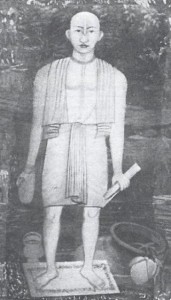
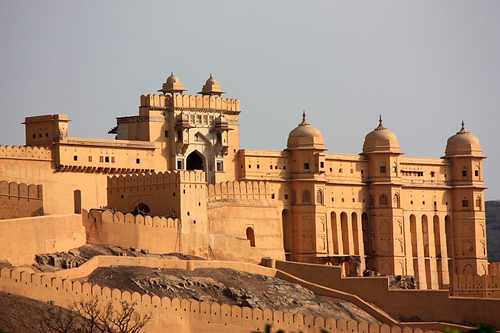










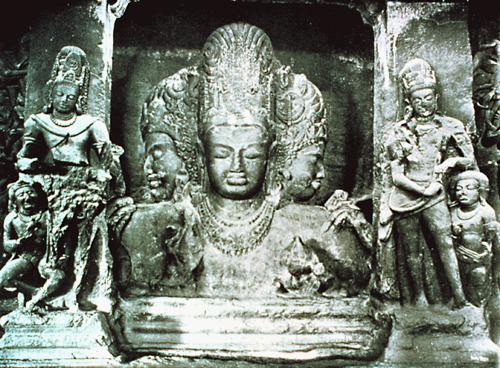
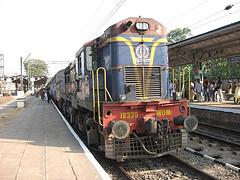
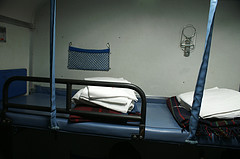
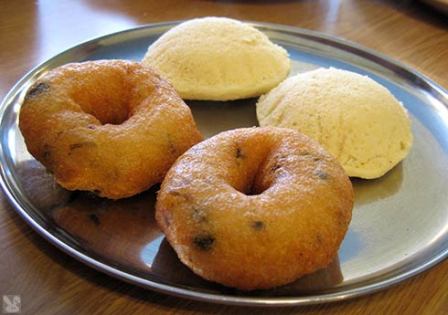

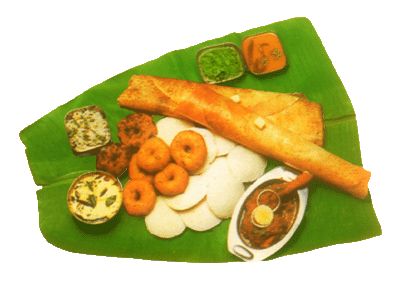

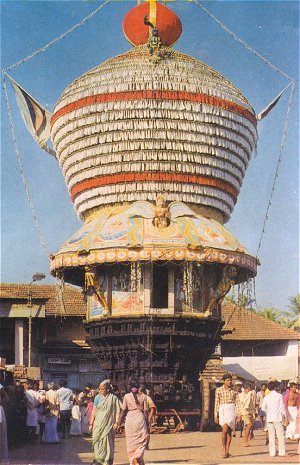

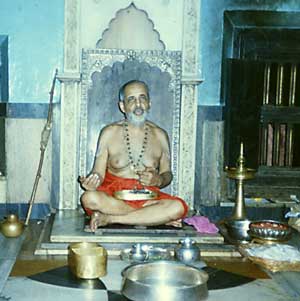
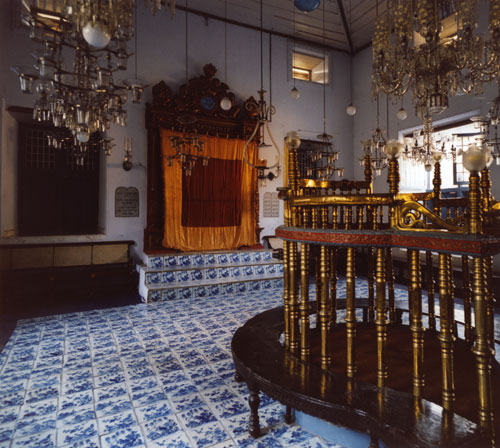
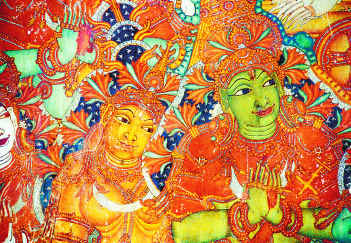
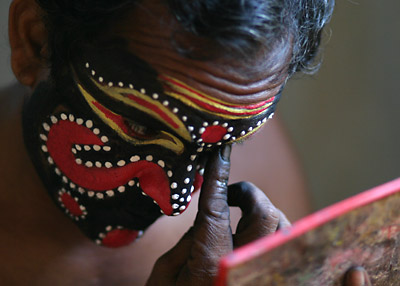

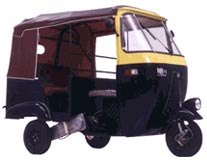


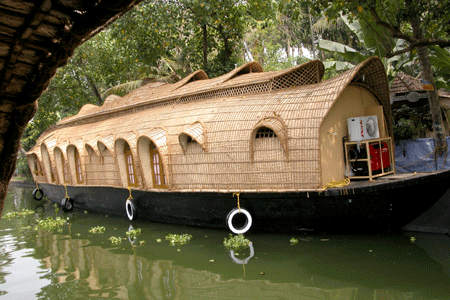

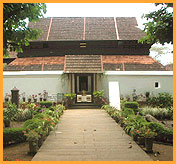
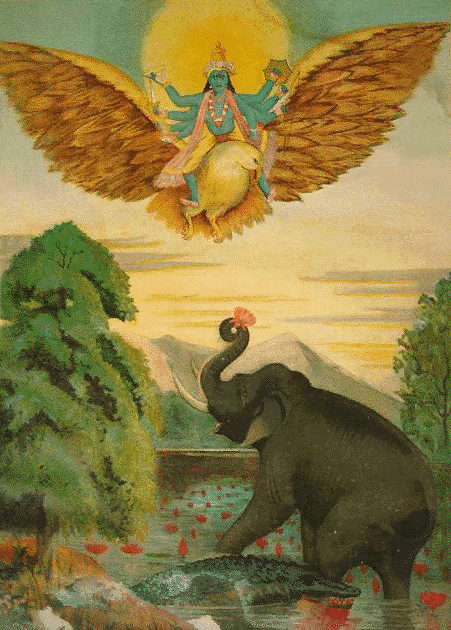
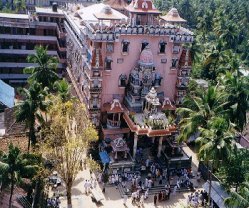
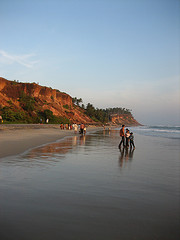
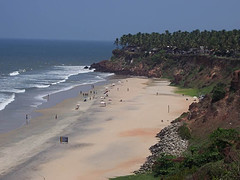


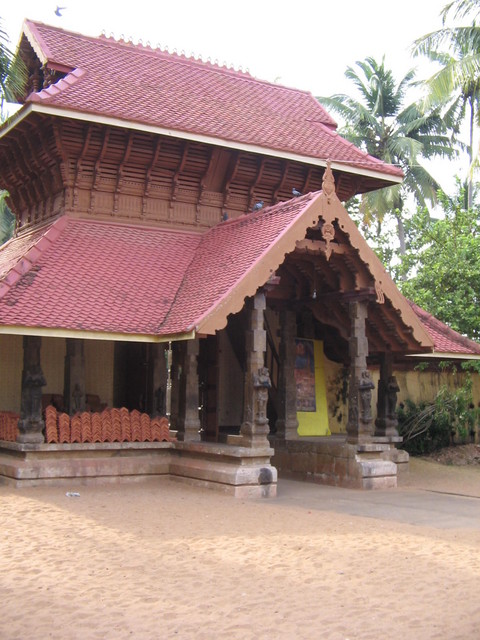
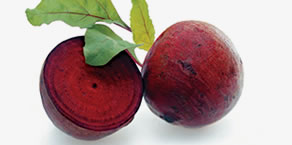



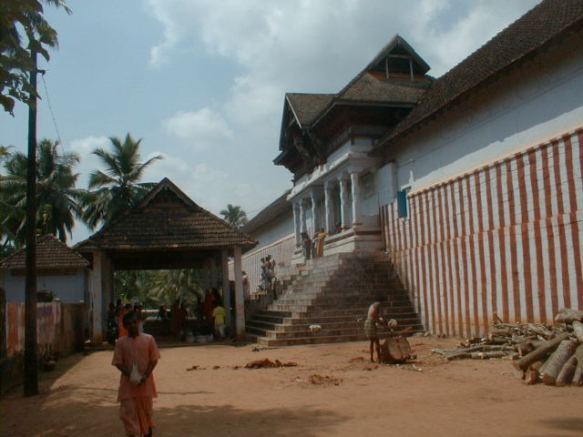

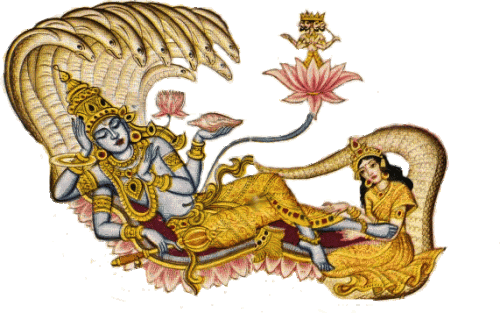
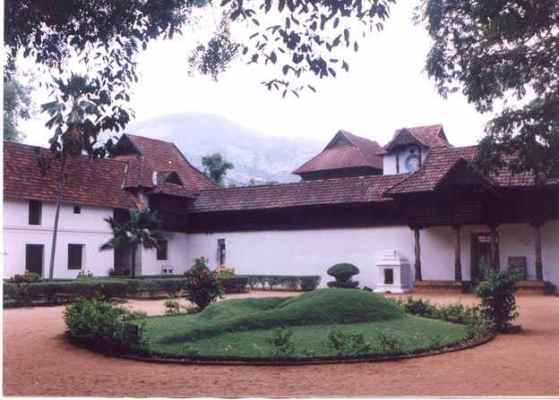
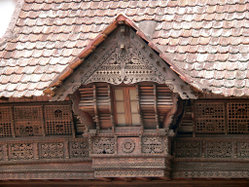

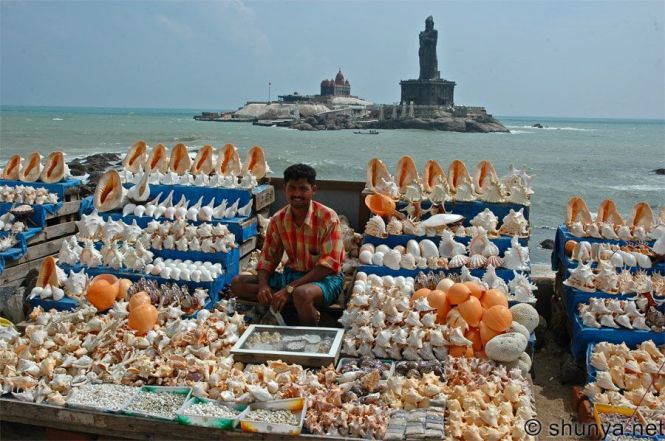

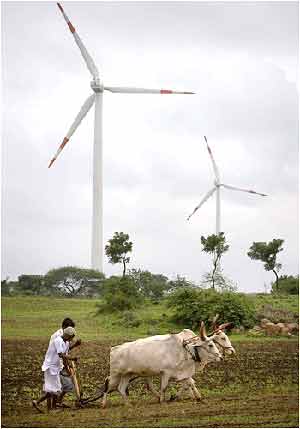

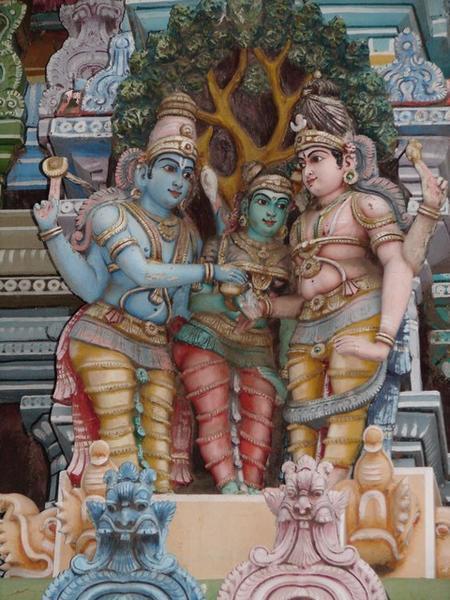
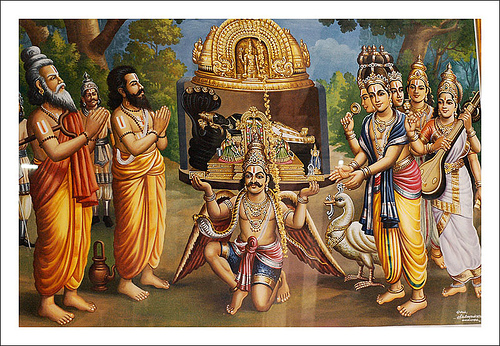
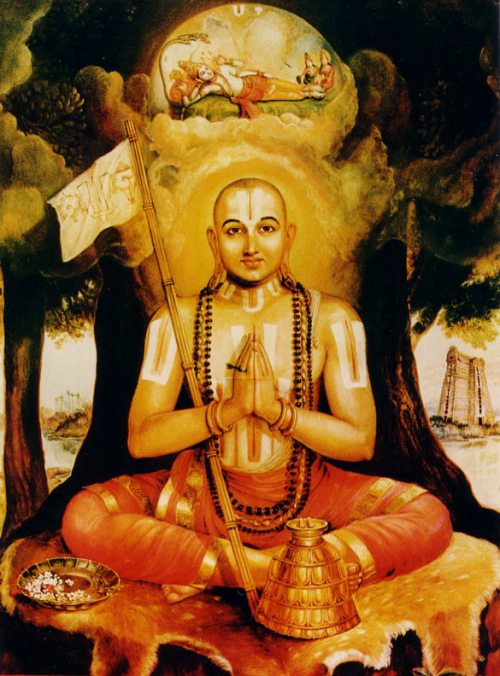

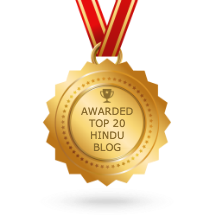
It was a great trip, Kripamoya, and lovely to revisit it through your eyes, hope there is more travel journal to come! Regards Moira
Thought your trip was great but you missed the real Tamil Nadu, the birth place of modern Vaishnavism.
More of my India Diary, including a section on Tamil Nadu, will be along shortly…
Haribol! Kripamoyaji – humble obiesances, all glories to Srila Prabhupada. I enjoyed reading about your witty South Indian tour . Pity you were uanable to have darshan at the Ananta Padmnabha Kshetra. Looking forward to more of your renderings.
Very inpiring and excellent.
Hari Om, It was very nice & educative to read your post on your travel in our country & state. It makes me want to visit/revisit some of those places.The Lord Thayumanavar attended the confinement of a poor devotee, not a queen as mentioned. It was painful to note that some places were out of bounds to you. I hope things would change soon and such distinctions are removed.
Respected Sir, I have seen your photographs,they were really fantastic. Our family is an orthodox family. Professionally I am a photographer. I like your photographs and I thank you for sharing them with us.
Thanks. It is good to hear from an orthodox Vaishnava family, and I am happy you found something of interest in this site.
As i was reading your diary i felt as if i was touring along with you to all these pilgrimage tourist spots.
Its quite disappointing that you were not allowed in some temples. But it is only because of your good deeds in last birth that you have got the opportunity to visit all these pilgrimage places and significant temples such as rameswarm, madurai, trichy etc, which we many Indians ourselves have not got the chance to visit. It was nice to read your tour.
The writting and (photos) are simply beautiful. You are not a hindu (documentally!!)?. But a spiritually enlightened & god loving person and what else is needed? I was reading very enthusiastically the writing (and photos). You have missed Lord Guruvayoorappan Temple in Kerala (the famous Sreekrisna temple) -due to restrictions!. I could note that you do not have any complaints about the entrance restrictions – hope the things will change, the worshippers, real devotees shall not have any difficulties visiting the sacred temples any where in the world. God bless you.
Nice to read about your trip to Kanyakumari district where I lived for 20 years and glad you were allowed to see AdiKesava (the brother temples!) There is a great temple at Sucheendram (Suchindram) for the trinity (Thanumalaya swamy) on the way to Kanayakumari from Nagercoil. I hope you enjoy it on your next visit. I got some great information on Ramanujacharya from your blog. Namo Narayanaya!
Thank you all for your most welcome comments. I have been quite surprised to read how many of you – who live in India – have found this blog helpful. And the last comment, from Krishnan, that you have discovered some information about Sri Ramanujacarya, was very rewarding for me. I know very little, and I write mainly to introduce others in the West to these subjects, so to read that you’ve found whatever I’ve written of interest is very gratifying. Thank you!
Great work,
Thanks to you
Ramanujam
Hare Krishna Prabhu! Its very interesting to read your article, particularly South India. And also you have mentioned that “Tamil Language is a favorite” of yours and as a Tamil people we are so happy about this… And by the mercy of Srila Prabhupada the whole world now get to know about this Glorious temples…. All Glories to Srila Prabhupada…
hello sir i am praba from trichy.when i saw your article,i was amazed and so happy. your article is so nice. i was so happy to see your article.this is so beautiful and wonderful.thank you sir for giving this beautiful article.then all the best for your future projects……..
Dommage que ce merveilleux document ne soit pas traduit en français ! Les photos sont sublimes et j’ai néanmoins effectué un beau voyage ! Merci !
Willy,
hi , its good to post these . we INDIAN also do the same so that the knowledge shall be in real and depth. even i dont know these places (though my family members hav visited these and just had a pics of themselves in sea etc )and not visited ..but will visit .
good job done
😉
Hare Krsna, Prabhu,
What a wonderful description of your travels! I have been to a few of the places, but it is like visiting them again to read your stories… Beautiful pictures! I look foward to reading more…
ys, ysdd
Very Good information..
Thx
hello sirs, it was a nice story to hear and it was an experience to know as if had been traveling,wow ,where did you have the beetroot and ginger,may be i can try one when i go on the track hareena
Very nice Diary.
Are you ever in Italy and or Austria too?
When are you in India again?
How can one stay in ISKCON?
Yes, Amit, sometimes I do come to Italy, although not often to Austria. How you can stay in ISKCON? You can stay at any of our centres by contacting the guestmaster and arranging accommodation some time in advance; or you can become a member (and hopefully remain a member) simply by aligning yourself with the beliefs and practises of the devotees, or offering your support in some way.
Hare Krishna !! Beautiful narration. Your article is filled with devotion to the Supreme Personality of Godhead Lord Krishna. May it inspire all of us always. !! All Glories to Srila Prabhupada.!
OM NAMO NARAYANAYA
Let all surrender to the Lotus Feet of Lord Shri Hari and enjoy the eternal bliss. Your devotion is admirable. Pl continue your service to mankind and pray for the peace.
You went to Madurai, and it is perhaps without knowing that you missed Azhagar in Thirumaliruncholai (within the city of Madurai).
People mostly refer to the Subrahmanya Swami temple there, but Azhagar, as the name suggests, is quite handsome and wonderful.
Great journal, and if only you can manage another visit, DO NOT miss these places:
1. Tirupati
2. Chennai, and my dear Shri Parthasarathy at its heart in Triplicane
(It is the only place where Krishna is present along with Rukmini Thaayar, Balarama, Satyaki, Pradyumna and Aniruddha)
3. The Nava tirupati temples which are a 3 hr drive from Madurai (One of those 9 famous temple-villages is my native place).
Speaking of Shri Parthasarathy, He has arrow-marks all over His face, which people say is due to the wounds inflicted on Him by Bhishma.
The metal was recast three times, but the scars remain.
Another thing about Him is that He has the stretch mark on His waist, where Yashodha tied Him to the mortar.
I found this peice quite interesting:
//Visiting Sri Rangam gave me some insight into the essential factors for developing and sustaining Vaishnava culture in any part of the world: Spiritual purity, knowledge from and devotion to the predecessor acaryas; determination; scholarship and intellectual strength; production of literature; dissemination and popularisation of the tradition; systematising and sustaining of temple worship and religious culture; support from leaders and thinkers; and protection from enemies.//
Yes, you are absolutely right about this. But, we need a lot of infrastructure built into the system. While the dissemination of knowledge has been immaculate perhaps in Sri Rangam, and a few other such divya deshams, it is not the case everywhere.
According to the Sri Vaishnava tradition, when the Lord comes out for an utsav, He is flanked by scholars adept in both the Vedas (Sanskrit) and the Divya Prabandham.
Nammazhwar says ”veda ozhiyum vizha ozhiyum- pizhai kuzha vilaiyattoliyum maraa thiruperaiyin servan naane” (Oh! I am a surrendered devotee of Tiruperai, where the sound of vedas, the sound of utsav, and the happy voices of children to see whom Lord Kuzhaikaathar asked Sri Garuda to step aside are there forever).
Where is the urge for my generation (read: present) to learn the Vedas, or Prabandham? Even if they learn out of Bhakthi as they usually do, they have no remuneration, or encouragement to continue Shri Kainkaryam. Most boys choose to pursue an engineering degree to feed his poor household over a life in the temple, or in the spreading of the teachings of Shri Ramanuja.
I know I stand a dangerous chance of being contradicted with ‘if they have Bhakthi, they’ll serve’ kind of hypothesis, but we need a system where young boys, eager in Bhakthi, wouldn’t have to sacrifice anything more than their friends in school, to be involved in the temple activities.
The Christian church has people vying to become Ministers, if only they had the will and conduct, so why is it that we have let our priests wallow in poverty?
As the first servants of the Lord, they are definitely entitled to more than that.
I am not saying that serving in the temple must be a paid-for job for which anyone becomes eligible.
But, today the sad case is that, most people, who would love to engage themselves in the service of the Lord, end up in the humdrum of a corporate office, as they need to meet financial constraints at home. Their Bhakthi doesn’t diminish, but they do not find it possible to channelize it to full time service.
It is these people that the Vaishnava community must come out to help.
All great acaryas, including Sri Ramanuja, have asked us to ‘serve’.
Service begins by serving these servants of the Lord.
The true dictat of Vaishnavism, in any Sampradaya, is service, in love, and spreading the names and glories of the Lord.
As Nammazhwar said, and as Sri Ramanuja envisioned, there must be the joint, and rising chorus of Vedas and Prabandham in all 108 divya desams.
People must come eagerly to serve the Lord: and the lack of a financial support, or incentive, must not hinder their Bhakthi Marg.
Thank you very much prabhuji, for posting your experience. I felt it like a recap of Radhanath maharaja’s 2010 South India yatra. Altough you were not allowed in some temples, you have not complained but still respected them. This is the true nature of a Vaishnava. May be to make you exhibit that quality, Lord has dramatized such a situation. Any ways, glories to you, glories to acharyas, glories to Lord Krishna and glories to the bhakti towards him.
very nice pics.
I would like to use your image of Vishnu reclining on the coils of Ananta in an e-book I’m writing about the Eden myth. The section in which I wish to use this image is on mythic serpent symbolism. Do I have your permission to use the image, and under what conditions?
Tim Callahn
I must be honest and tell you that I do not own the image but used it without authorisation from the owner – who I could not find at the time.
It is a wonderfull knowledge of Lord Krishna related to South India.
Interesting to read about the great acharyas. Nice article prabhu.
The write up is really nice and my sincere thanks to you sir. I enjoyed reading your description of finer details at each place and temple. I can say it is a travel guide for me to visit many Vaishnava temples in India. Thank you very much again.